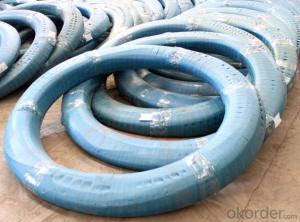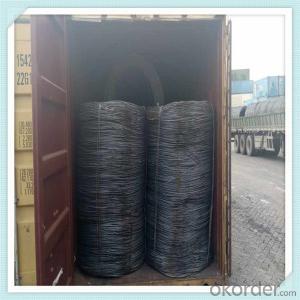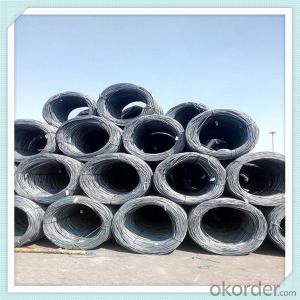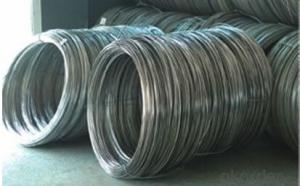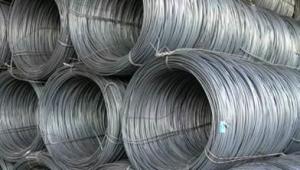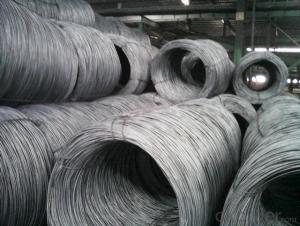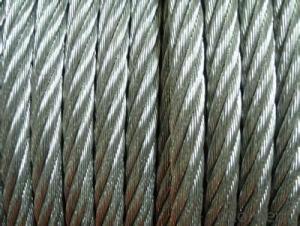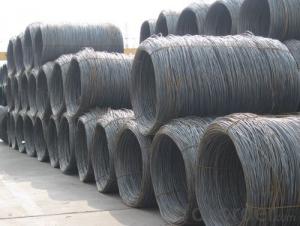Strand Hot Rolled Steel Wires
- Loading Port:
- China Main Port
- Payment Terms:
- TT or LC
- Min Order Qty:
- -
- Supply Capability:
- -
OKorder Service Pledge
OKorder Financial Service
You Might Also Like
Quick Details
| Steel Grade: | SWRH77B, SWRH82B | Standard: | ASTM,BS,GB,JIS | Wire Gauge: | 4.0mm-10.0mm |
| Place of Origin: | Tianjin China (Mainland) | Type: | Drawn Wire,Spiral/Helical Ribs, Round Plain | Application: | Construction |
| Alloy Or Not: | Is Alloy | Special Use: | Free Cutting Steel | Model Number: | 4.0-10.0mm |
| Product Name: | prestressed steel wire 4mm high carbon steel wire | Size: | 4.0-10.0mm | ||
| Strength: | 1570/1670/1770/1860 N/mm2 | Relaxation: | Less than 2% (1000hour) | Elongation: | Not less than 4% |
| MOQ: | 10 Tons | Payment: | TT, LC | Delivery: | 10-15 work days |
| Package: | As your requirements |
Packaging & Delivery
| Packaging Detail:steel strand coil to be packed in damp proof materials strapped with 8 bands on one wooded pallet with an outer layer of plastic used for anti-rainshower 2 or 3 wooden block undermeath each coil. | |
| Delivery Detail:within 2 weeks |
Specifications
high carbon class A steel wire
Constructon:7 steel wire
material:wire 82B
FAQ of Strand Steel Wires
①How is the quality of your products?
Our products are manufactured strictly according to national and internaional standard. If you want see our quality certifications and all kinds of testing report, please just ask us for it.
Guaranteed: If products’ quality don’t accord to discription as we give or the promise before you place order, we promise 100% refund.
②How about price?
Yes, we are factory and be able to give you lowest price below market one, and we have a policy that “ for saving time and absolutely honest business attitude, we quote as lowest as possible for any customer, and discount can be given according to quantity”,if you like bargain and factory price is not low enough as you think, just don’t waste your time.Please trust the quotation we would give you, it is professional one.
③Why should you chose us?
Chose happens because of quality, then price, We can give you both.Additionally, we can also offer professional products inquiry, products knowledge train(for agents), smooth goods delivery, exellent customer solution proposals.Our service formula: good quality+good price+good service=customer’s trust
SGS test is available, customer inspection before shipping is welcome, third party inspection is no problem.
Strand Hot Rolled Steel Wires Images
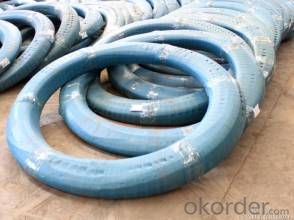
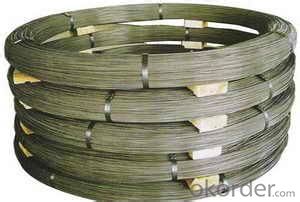
Any question, pls feel free to contact us !
- Q: What are the different wear testing methods for steel wire rod?
- Steel wire rods can be evaluated for their performance using various wear testing methods. These methods aim to replicate real-life situations and determine the durability and wear resistance of the wire rods. Here are some commonly used wear testing methods for steel wire rods: 1. Pin-on-Disk Test: Analyzing the wear scar on a rotating disk provides insights into the wear and frictional properties of the wire rod. This is achieved by pressing a pin-shaped sample of the steel wire rod against the disk under controlled conditions. 2. Ball-on-Disk Test: By observing the wear scar on the disk caused by the interaction between a steel ball and the wire rod, the wear and frictional behavior of the wire rod can be evaluated. The ball is placed on a rotating disk for this test. 3. Abrasion Testing: Evaluating the wire rod's resistance to wear involves subjecting it to abrasive conditions. Tests such as the Taber abrasion test or the ASTM G65 test rub the rod against an abrasive material or surface to determine its performance. 4. Sliding Wear Test: This test simulates the sliding motion between two surfaces. The wire rod is placed against a counter surface, and controlled force is applied while the surfaces slide against each other. The wear scar on the counter surface is examined to measure the wire rod's wear and frictional properties. 5. Wear Simulation in Real Applications: Sometimes, wear testing involves exposing the steel wire rod to actual application conditions. This can be done by utilizing the wire rod in specific machinery or equipment and then assessing its wear resistance and performance based on observed wear. These diverse wear testing methods allow researchers and manufacturers to assess the wear resistance and durability of steel wire rods in different scenarios. By understanding how the wire rod performs under various wear conditions, improvements can be made to its material composition or manufacturing processes to enhance wear resistance and overall performance.
- Q: How is steel wire rod used in the manufacturing of wire for agricultural fences?
- Steel wire rod is an essential raw material in the manufacturing of wire for agricultural fences. It serves as the primary material that is drawn, twisted, and coated to create the final wire product. The high tensile strength and durability of steel wire rod make it ideal for withstanding the harsh conditions and stress that agricultural fences are subject to. Additionally, the flexibility of steel wire rod allows for easy installation and ensures that the wire can be securely fastened to fence posts.
- Q: How does the corrosion resistance of steel wire rod vary with different wire drawing processes?
- The corrosion resistance of steel wire rod can vary depending on the specific wire drawing processes used. Wire drawing processes involve pulling the steel wire rod through a series of dies to decrease its diameter and increase its length. One important factor that affects the corrosion resistance is the surface finish of the wire after the drawing process. Wire drawing processes can result in different surface finishes, such as bright, galvanized, or coated. These surface finishes can provide additional protection against corrosion by acting as a barrier between the steel wire rod and the corrosive environment. Another factor that influences corrosion resistance is the reduction in diameter during the wire drawing process. As the diameter decreases, the surface area of the wire increases, which can lead to increased corrosion susceptibility. However, this can be mitigated by selecting appropriate wire drawing processes that provide a consistent and uniform reduction in diameter, as well as by utilizing corrosion-resistant coatings or treatments. Additionally, the choice of wire drawing lubricants and cooling methods can impact the corrosion resistance of the steel wire rod. Proper lubrication during the drawing process reduces friction between the wire and the dies, minimizing surface defects and potential corrosion sites. Effective cooling methods can prevent overheating of the wire during drawing, which can also affect its corrosion resistance. In summary, the corrosion resistance of steel wire rod can be influenced by various factors related to the wire drawing process. These include the surface finish, reduction in diameter, lubrication, and cooling methods employed. By carefully selecting and optimizing these factors, manufacturers can enhance the corrosion resistance of steel wire rod, ensuring its long-term durability and performance in corrosive environments.
- Q: How is steel wire rod packaged for transportation?
- Steel wire rod is typically packaged for transportation by being bundled together and secured with steel strapping or wire ties. The bundles are then stacked on wooden pallets or loaded into steel crates for added protection. Additionally, some manufacturers may opt for further packaging using shrink wrap or plastic covers to safeguard the wire rod from moisture, dust, and other potential damages during transit.
- Q: What are the common industry skills for steel wire rod professionals?
- Some common industry skills for steel wire rod professionals include knowledge of steel production processes, proficiency in operating machinery and equipment used in wire rod production, understanding of quality control and inspection techniques, ability to interpret technical drawings and specifications, familiarity with safety protocols and regulations, and strong problem-solving and troubleshooting skills. Additionally, effective communication, teamwork, and time management abilities are also highly valued in this profession.
- Q: How are steel wire rods used in the production of barbed wire?
- Steel wire rods are used in the production of barbed wire by being rolled and twisted together to form the central wire strand. This strand is then attached to sharp barbs, which are evenly spaced along the wire, creating the distinctive and effective deterrent of barbed wire.
- Q: What are the safety precautions when handling steel wire rod?
- Some safety precautions when handling steel wire rod include wearing appropriate personal protective equipment such as gloves, safety glasses, and steel-toed shoes to protect against cuts, burns, and eye injuries. It is important to handle the wire rod with caution, avoiding sharp edges and ensuring proper lifting techniques to prevent strain or injury. Additionally, proper storage and handling procedures should be followed to avoid tripping hazards and to prevent the wire rod from falling or rolling. Regular inspections of the wire rod and equipment should be conducted to identify any defects or potential hazards.
- Q: What is the standard length of steel wire rod?
- The standard length of a steel wire rod can vary depending on the specific industry and application, but it is commonly around 6 to 12 meters (20 to 40 feet).
- Q: What are the advantages of using steel wire rod in medical applications?
- The advantages of using steel wire rod in medical applications include its high strength and durability, which allows for reliable and long-lasting medical devices. Additionally, steel wire rod is highly resistant to corrosion, ensuring a sterile and hygienic environment. Its flexibility and malleability make it easy to shape into various medical instruments and implants. Moreover, steel wire rod is cost-effective and readily available, making it a practical choice for medical applications.
- Q: How is steel wire rod used in the manufacturing of wire rope pulleys?
- Steel wire rod is used in the manufacturing of wire rope pulleys as it serves as the raw material for the production of wire ropes. The wire rod is drawn, twisted, and braided together to form the wire rope, which is then wound around the pulley. This provides the necessary strength and durability for the pulley to effectively support and guide the wire rope in various applications such as lifting heavy loads or transmitting mechanical power.
Send your message to us
Strand Hot Rolled Steel Wires
- Loading Port:
- China Main Port
- Payment Terms:
- TT or LC
- Min Order Qty:
- -
- Supply Capability:
- -
OKorder Service Pledge
OKorder Financial Service
Similar products
Hot products
Hot Searches
Related keywords
